what equipment do i need to reload rifle ammo
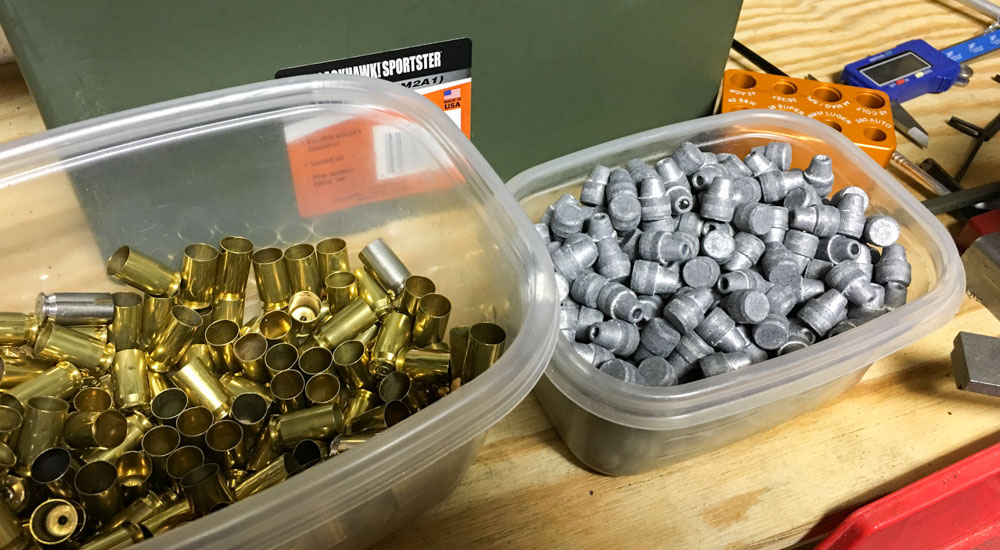
What do you really need to reload your own armament? Read on to find out…
Series
Part 1: Want to Reload Your Own Ammo? Basic Questions to Consider
Office 2: The Reloading Process
Function 3: The Gear You'll Need and What It'll Cost Yous
Part 4:Brass Cleaning and Grooming to Load
Part v: Brass Resizing
Part six:Trimming Cartridge Cases
Role 7:Repriming the Cartridge Case
Role 8:Pulverization, Propellants, and Pressure
Part 9: All Virtually Primers
Office 10: Projectiles: Materials, Weights, and Styles
Role 11: Seating and Crimping Bullets
Part 12: To Crimp or not to Crimp
Part xiii: Terminal Inspection and Packaging Tips
In that location is such a fine line betwixt needs and wants. It's oh so easy to consider something that's really a "desire" as a "need." You lot know, like bacon is technically a "want." Hang on, upon further reflection that is, in fact, a demand. But yous get the idea.
The outset question prospective reloaders e'er ask me is, "How much will information technology cost me to get started?" The trouble with that question is that information technology depends. It depends on whether you want to reload for rifle, pistol, or both. It depends on the number of calibers you lot want to reload. Only more than annihilation, it depends on your personal definitions of needs and wants.
The list of stuff you truly need is actually pretty modest. When I say need, permit's consider the extreme and rule out gear that simply makes the job easier or faster. Those things are "wants" and you can always add together that stuff subsequently. Here, I'll use this criterion to define gear y'all need: If you can't SAFELY reload a cartridge without it, then information technology's a need.
And so here's the list of gear you need to safely reload pistol ammunition. At the finish, I'll mention what you need to add if y'all want to reload bottleneck rifle cartridges. We'll address the benefits of those pieces of "want" gear in a later on article in this series.
Cartridge Case Cleaner
When you pick upward fired brass cartridge cases, they'll be dirty. Depending on whether you shoot at an indoor or outdoor range, the relative level of "clay" will vary. At a minimum, y'all'll desire to remove whatever loose powder residuum and whatsoever clay your brass caused when it hit the floor. While your contumely does non have to be shiny like new, it does need to have the loose dirt removed. That's because the brass needs to piece of work smoothly with your reloading dies, and when finished, it needs to reliably load into your gun. If brass is covered with sand and Twinkies filling, you're going to mess upwards your dies and run into reliability problems later.
If you desire to stick to bones needs, you can make clean your brass with stuff you lot already have. Hot h2o, a plastic container and some Tide (or a mixture of dish detergent, vinegar, and salt) will go the job done. Throw the dirty brass in there, shake the snot out of it, rinse, and dump on a towel for a day or so to dry out. It won't look pretty, just you'll achieve the goal of removing loose clay.

Sooner or later on, you'll want a tumbler or ultrasonic cleaner, but you lot don't need either right away.
Your brass won't be all pretty and shiny, but it will be clean plenty to reload. To me, this is a hassle that'due south not worth saving 60 to eighty dollars on a brass cleaner. These come up in various types including ultrasonic cleaners, dry tumblers, and wet tumblers. Since a cleaning car is a "desire" we'll get into those in much more than item subsequently in the serial.
Cost: $0 dollars. Since nosotros're being hardcore nigh wants and needs, we'll assume you can start with a saucepan or other container and acquire a fancy instance cleaner down the route.
Reloading Press
This component is a need, although you tin become started with a very simple and inexpensive single-stage (or even hand operated) reloading press.
Recollect of a reloading press like ane of those old Play-Doh factories. You know, the ones where you dump Play-Doh in a hopper and press a large lever, then it comes out like star-shaped spaghetti. Similar the Play-Doh manufactory, a reloading press is simply a device that uses mechanical reward to squish things together.

A well-used Lyman single-phase reloading press.
You lot can do these things with a reloading printing:
- Printing a brass instance against a decapping pin to button out the erstwhile primer.
- Press a casing into a resizing die that jams the contumely dorsum into its original dimensions.
- Press a new primer into the now empty primer pocket.
- Press the casing confronting an expanding die that opens the rima oris simply a tad so you can insert a new bullet.
- Press the bullet down into the casing.
- Crimp the casing around the bullet to remove the bell from the expansion stride.
What type of reloading press do you need to go started? I always recommend starting with a single stage press. Single phase ways the printing does ane thing at a time. Using a single phase press, you'll load in batches. For instance, y'all'll resize all your cases, then prime number them all, so add powder, then seat the bullet and finally crimp all of the cases. While it's more tedious, a single stage press is unproblematic to learn, forgiving, and most important for this discussion, inexpensive.
Cost: $150. These range higher and lower in cost, but you tin can buy a good that will last you 115% of forever for this price.
Die Ready
Reloading dies are simply cylinders made of steel that are used similar "inserts" with your reloading press. Following from the previous example, they're kind of similar those yellowish plastic cutouts for the Play-Doh Manufactory. Every bit the interior of a reloading dice is cut specifically to lucifer the shape of the blazon of cartridge, y'all need a set of dies for each caliber you lot wish to reload.
The reloading dies screw into the reloading press. The press is then used to jam the cartridge case into the reloading die to perform the specific function of that dice. For instance, in that location are three types of dies in virtually pistol quotient reloading die sets.
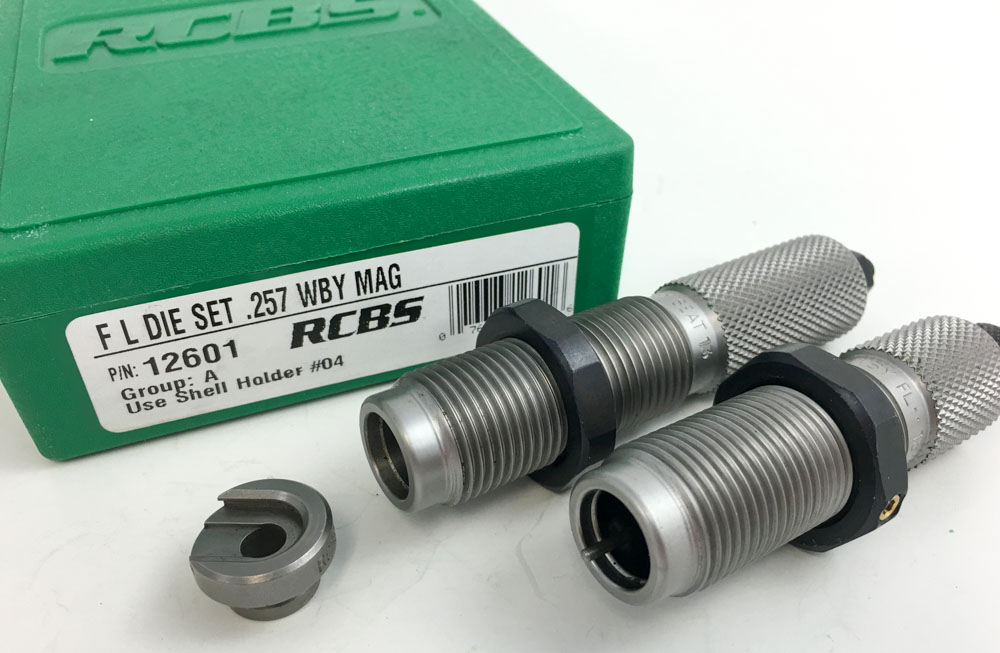
Many rifle die sets similar this .257 Weatherby Magnum kit comprise just 2 dies.
Decapping and Resizing Die
This die does two things in one step. A steel rod right in the center goes through the open oral cavity of your cartridge brass and pushes out the erstwhile blown up primer. The dice itself is shaped exactly similar the outside of your cartridge brass, and the diameter of the die hole is the exact dimension specified for that quotient cartridge diameter. It "pushes" the contumely cartridge back to the proper bore so it will easily fit in the chamber of your gun.
Expanding Die
The resizing die reshapes the whole cartridge case dorsum into a proper sized tube. But expect! We're going to have to stick a new bullet in there at some signal, right? Will it fit? That's where the expanding dice steps in. This ane but opens the very terminate of the mouth of the cartridge case so you lot tin fit a new bullet in in that location.
Seating and Crimping Dice
This is another dice that accomplishes two tasks. Get-go, it pushes the bullet down into the case to the proper depth, based on how you lot accommodate it. At the same time, information technology presses the case mouth in to remove the oral cavity expansion created during the expansion stride. Some pistol die sets, like Lee Palatial Pistol Dice Sets, have four dies. These simply split up the seating and crimping functions into ii separate dies. Treating seating and crimping as split up operations tin can be a little more forgiving.
You'll need a fix of dies for each quotient y'all wish to reload. Yous'll also demand a shell holder for each caliber. A crush holder is a small-scale insert for your reloading press. Information technology slips onto the tiptop of the piston of your reloading press and grips the rim of your cartridge case — belongings it snug while you jam the case into the reloading dies. Some die sets include a vanquish holder, and some practise non, so be sure to check and club information technology separately if needed. You'll also need a shell holder for each quotient you want to reload.
Toll: $50. Like anything, the price of die sets varies, but y'all should take no trouble finding skilful pistol quotient dies for less than $50.
Powder Scale
A scale is an absolute necessity in my view. Charging cartridges with either too piffling or too much pulverization is dangerous! Recipes for reloading utilise weight measurements for the amount of powder required. Powder is measured in units of grains, which is ane/7,000th of a pound – it doesn't mean individual kernels of pulverization. While some basic reloading kits provide scoops of different sizes to measure powder, this method will e'er be less precise than weighed measures. Sermon over – become a scale right when you kickoff.
Powder scales come in two different types: beam and electronic. Traditional beam scales never need batteries and ever work. Electronic scales are becoming more than affordable and are pretty darn reliable too provided yous keep the batteries fresh. I've seen them become wiggy as the batteries commencement to drain.
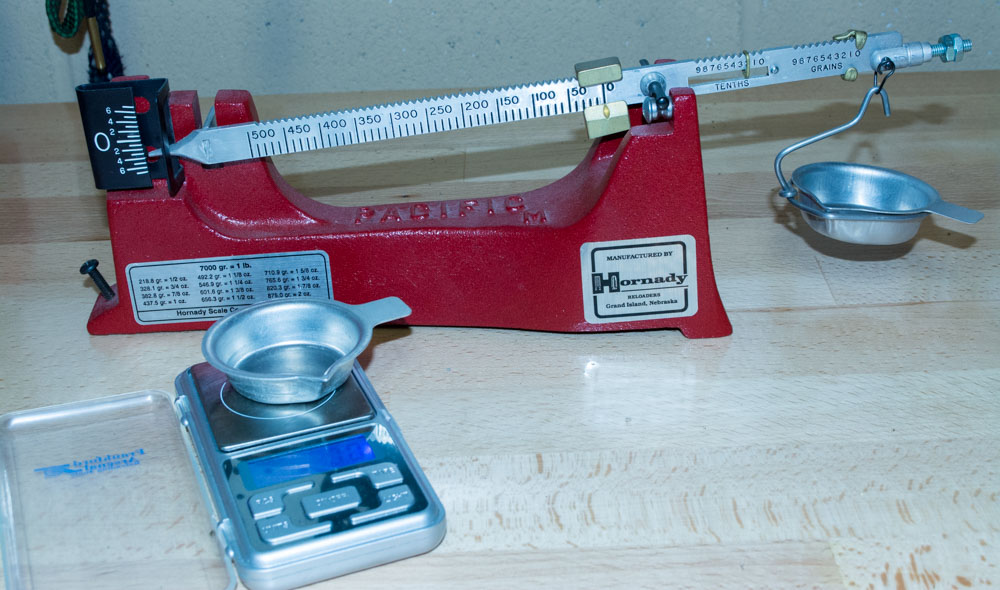
Yous need a powder scale and both beam and electronic ones piece of work fine.
Cost: $75. Calibration prices go from $30 to $300 depending on how precise you want to go. You tin can get a decent axle scale in the $sixty to $90 range. Some of the newer electronic scales dip downwards to $thirty or so, but there seem to exist a broad diversity of good ones in the $125 range.
Calipers
While not included in nigh starter kits, I think calipers are a must-have item. Bachelor in analog dial or digital, a caliper accurately measures things.
The most important measurement yous'll need to worry about is the overall cartridge length. It's critical to make sure that your bullets are seated deep enough to feed reliably, but not so much that y'all reduce interior case volume and risk dangerous over pressure. A reloading manual will tell you exactly how deep to seat each caliber and specific bullet type.
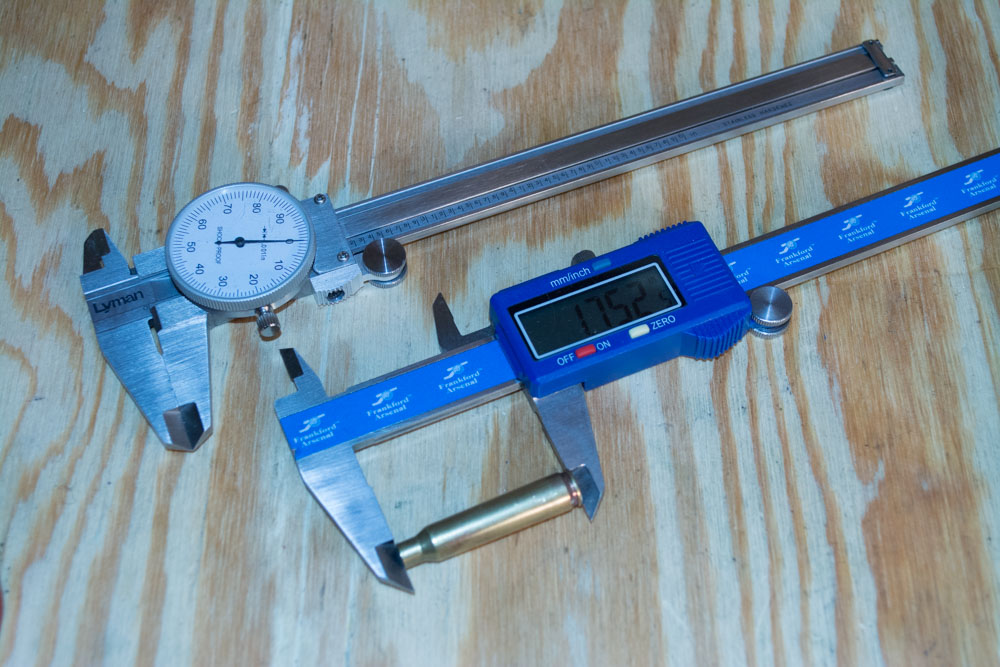
Analog (top) and digital (bottom) calipers for measuring stuff precisely.
Calipers are also handy for checking the diameter of your cases, merely generally, your dies will ensure that cases are sized to the right width.
If y'all are going to reload bottleneck rifle cartridges, you'll besides need calipers to make sure that your resized cases are the proper length before you starting time to seat bullets. They tend to stretch a bit when you fire and resize them.
Cost: $40. You can get either digital or analog (dial readout) calipers in this price range, and the quality of those is plenty skilful plenty to get yous going safely.
Reloading Manual
Do not reload ammunition, always, without a reloading manual. Think of this equally the cookbook total of recipes for each caliber, powder type, primer type and bullet type and weight. Reloading component and equipment companies like Hornady, Lyman, Speer, Barnes, Nosler, Sierra and Lee all publish books with detailed recipe information. Ever, always, ever stick to published guidelines for your reloads!
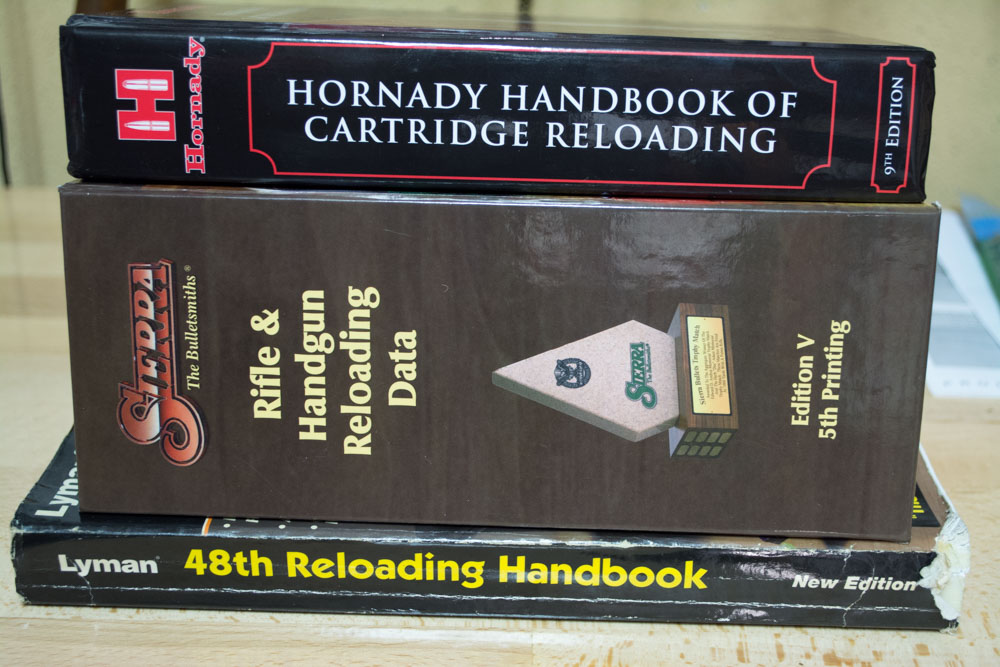
Even though reloading recipes from reputable companies are available online, a volume will actually help yous every bit information technology contains lots of boosted information.
You can go reloading recipes online, but if you do, stick to data published by the companies that brand the bullets or pulverisation. Don't assume that some recipe from Billy Bob'due south Boom 'Em Up Forum is condom.
Cost: $25.
Rifle Cartridges: Instance Trimmer
When you resize burglarize cartridge contumely, information technology volition stretch a trivial each time you reload information technology. So you'll need to invest in a uncomplicated device that trims excess contumely from the mouth of the case.
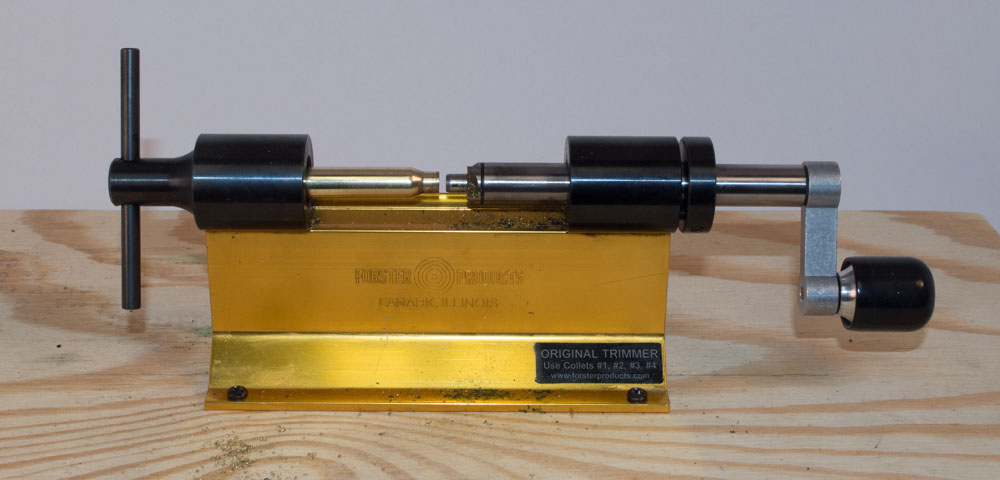
A hand-operated case trimmer like this Forster model will get you started with bottleneck rifle cartridges.
The thought for virtually all types of case trimmers is simple. It'south a lathe-type tool, either hand-operated or electric. You fasten the brass cartridge case on the rim terminate, and a rotating blade trims off the excess brass from the open neck of the cartridge.
Toll: $100. Hand operated case trimmers start at $50 or so and escalate to three figures. The diversity of electric and single-caliber trimming tools is too much to cover here, and so we'll stick to the mitt-operated model. Besides, similar a unmarried-stage reloading printing, you'll employ a skillful transmission example trimmer forever.
So there you take it. If I've washed my math right, we're looking at virtually $340 in basic equipment to get started with pistol caliber reloading. Add a hundred if you want to practice burglarize calibers. Here's the good news. Companies similar Hornady, Lyman, RCBS, and Lee offer reloading starter kits which include different combinations of the gear we've talked almost here. These starter kits are priced at a substantial discount over what yous would pay separately. Kits range from nearly $150 to $450 or so and vary dramatically in terms of what's included. Most of them offering more than the most bones "needs" list we've discussed here, then you're getting some of those time to come "wants" correct upwardly front as part of the package.
Source: https://www.gunsamerica.com/digest/reloading-the-equipment-you-need/
0 Response to "what equipment do i need to reload rifle ammo"
Post a Comment